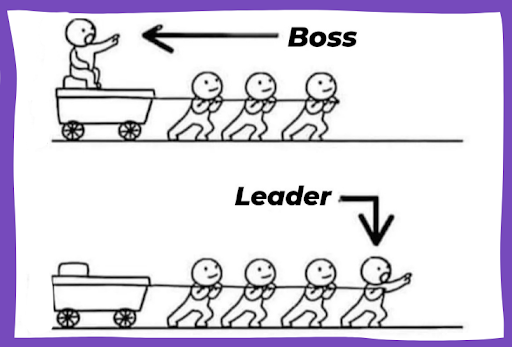While a leader can steer the organization towards its objectives, a boss without leadership skills may lead to wasted resources and a rudderless team.
A boss is an individual who managed employees by wielding power. Their role involves monitoring employees, delegating tasks, and ensuring assignments are completed on time. Bosses are there to enforce rules and regulations in the workplace. For instance, a factory supervisor might fit the description of a boss.
In contrast, a leader motivates and empowers their team to develop valuable skills in pursuit of collective goals. Leaders listen to team members, involve them in the decision-making process, and foster a positive work environment.
In this guide, we’ll draw a clear distinction between boss vs. leader and lay out steps to help you empower your team throughout the product lifecycle.
Table of contents
Boss vs. leader: What’s the difference?
In understanding the concept of leadership, it is helpful to contrast it with the concept of being a boss. The two terms, while often used interchangeably, encompass distinct roles, responsibilities, and styles of management in an organizational context.
Let’s explore the key differences that distinguish a boss vs. a leader:
| Boss | Leader |
|---|---|
| Manages a group of people, delegates tasks, and oversees their work | Motivates, influences, and guides others to achieve their goals |
| Possesses formal authority based on their position | May or may not have formal authority |
| Seeks control | Values support and collaboration |
| Focuses on accomplishing tasks | Concentrates on guiding others to fulfill their goals |
| Emphasizes rules and regulations | Highlights personal growth and development |
| Makes decisions independently and issues commands | Decides collaboratively based on input from others |
Impact on the workplace
A boss or leader significantly influences the workplace through the work environment their management style creates.
A boss tends to give orders and expects obedience, leading to a lack of autonomy and creativity among employees. Such stringent rules can create a stressful work environment.
Bosses might focus more on employee productivity rather than their well-being, potentially resulting in a high turnover rate. Furthermore, a boss who plays favorites or is not invested in the project can damage team motivation, collaboration, and creativity, negatively impacting employee morale and job satisfaction.
On the other hand, leaders foster a positive work environment by collaborating with employees and motivating them to perform at their best. They understand employee challenges and set flexible expectations, cultivating a unified and healthy workspace.
Leaders also play a vital role in nurturing future leaders by helping others develop their skills.
How strong leadership impacts team performance
A competent leader propels their team toward its objectives by making each member feel valued.
Let’s delve into a few specific ways in which robust leadership skills impact team performance:
- Create a culture of trust — Leaders nurture relationships with team members, fostering a culture of trust. An environment of trust facilitates open, honest communications, stimulating healthy discussions and brainstorming before decision-making
- Set clear expectations — Effective leaders understand business goals and set clear expectations for team members. This clarity gives the team a sense of purpose and direction
- Help others grow — Leaders focus not just on achieving business objectives but also on the growth of team members. They guide and support the team in problem-solving and provide opportunities to enhance their skills
Leaders encourage open communication and foster healthy discussions during product discovery, leading to innovative, high-quality products. They also communicate business objectives to the team while empathizing with customer needs.
Leading your team through the product lifecycle
Product development traverses various stages, from defining business needs and goals to launching the product.
Throughout the product lifecycle, product managers collaborate with marketing, customer success, design, and engineering teams to create products that address customer needs. It’s crucial that leaders from each unit share the same mindset to create an open and healthy work environment.
Let’s explore some specific ways in which leaders, as opposed to bosses, empower their teams to approach problems and solutions creatively throughout the stages of the product lifecycle:
1. Ideation
This is the initial stage of the lifecycle where product ideas are conceived and discussed based on identified business needs and opportunities.
Leader
During the ideation phase, a leader cultivates a culture of collaboration, idea sharing, and experimentation. They encourage their team to contribute creative solutions and involve them in decision-making processes.
Product managers who exhibit leadership qualities will value every team member’s input and foster a supportive environment for creative brainstorming during this stage.
Boss
In contrast, a boss may take a more directive role during the ideation stage. They might dictate the ideas to pursue, potentially stifling creativity and innovation.
As a result of this inflexibility, a boss may also make decisions unilaterally without seeking or valuing the team’s input, leading to a lack of ownership and commitment from team members.
2. Validation
The validation stage involves evaluating the feasibility and potential success of the conceived ideas before moving forward with development.
Leader
Leaders play an active role in the validation phase by clearly communicating the product vision and strategy. They guide the team to identify and develop ideas that align with business goals.
Moreover, product leaders foster open communication to ensure everyone is on the same page with the direction and objectives of the project. They understand what each role needs to know and deliver that information in a way that motivates and inspires the team.
Boss
A boss might maintain control over the validation process, focusing primarily on results and execution. This approach leaves little room for team members to question or validate the product’s feasibility and alignment with the business objectives.
It’s easy to see how the “boss” mentality might lead to missed opportunities for improving the product concept or strategy during the validation stage.
3. Prototyping
At the prototyping stage, initial product designs and features are created for review and refinement before entering the development phase.
Leader
Leaders provide constructive feedback on designs during the prototyping stage. They leverage their extensive product knowledge to ensure design consistency and manage cross-functional dependencies. Their open-minded and inclusive approach encourages team members to voice their ideas and concerns, enhancing the product design process.
Boss
A boss might approach the prototyping stage with a top-down directive style, instructing team members on how to execute their tasks without considering their insights or suggestions. This style can limit innovation and hinder the team’s ability to produce customer-centric designs.
4. Development
During the development phase, the engineering team develops the validated product design into a functional product.
Leader
Product leaders monitor the progress of development and provide support to overcome obstacles. They engage with the team, facilitating decision making to navigate complications and fostering an environment of cooperation and problem-solving.
Boss
In contrast, a boss may be less involved in the daily activities of the development stage, only stepping in when problems arise or to enforce deadlines. This hands-off approach can lead to a lack of guidance and support, which may negatively impact the team’s performance and the product’s development.
5. Launch
The launch stage involves introducing the developed product to the market and monitoring its initial performance.
Leader
Leaders actively participate in planning the product’s launch, working closely with the team to ensure accuracy. They stay informed about potential launch dates and timelines and communicate these effectively with the team.
A leader’s proactive involvement and communication helps the team prepare adequately for the launch and anticipate any potential challenges.
Boss
A boss might communicate launch dates and timelines to the team without involving them in the planning or decision-making processes. They may focus on the execution of the launch without considering the team’s readiness or potential challenges, which can lead to last-minute pressures and decreased product quality.
6. Improvement
After the product launch, this stage involves continuously assessing the product’s performance and making necessary adjustments based on feedback and performance data.
Leader
Post-launch, leaders play a significant role in monitoring KPIs to assess the impact of launched features. They collaborate with the team in defining these KPIs in line with business objectives and set expectations on long-term utilization of the analysis.
A product leader values continuous learning and improvement as a way to foster a culture of growth and development.
Boss
In contrast, a boss may focus primarily on the end result post-launch, such as sales figures or user numbers, without investing in continuous improvement or learning. They might overlook the importance of team collaboration in defining KPIs and setting expectations, which can lead to missed opportunities for product and team growth.
Conclusion
Every organization requires strong leadership to inspire and guide the team towards its goals. While a boss can manage tasks and enforce rules, a leader can motivate the team, foster a positive work environment, and contribute to the overall growth of the team and the organization.
If you aim to ascend the product management career ladder, it’s imperative that you transition from being a boss and embrace a leader’s mindset to create a positive impact on the organization.
The post Boss vs. leader: The difference and why it matters appeared first on LogRocket Blog.
from LogRocket Blog https://ift.tt/OoiVdNU
Gain $200 in a week
via Read more
Source link







Leave a Reply